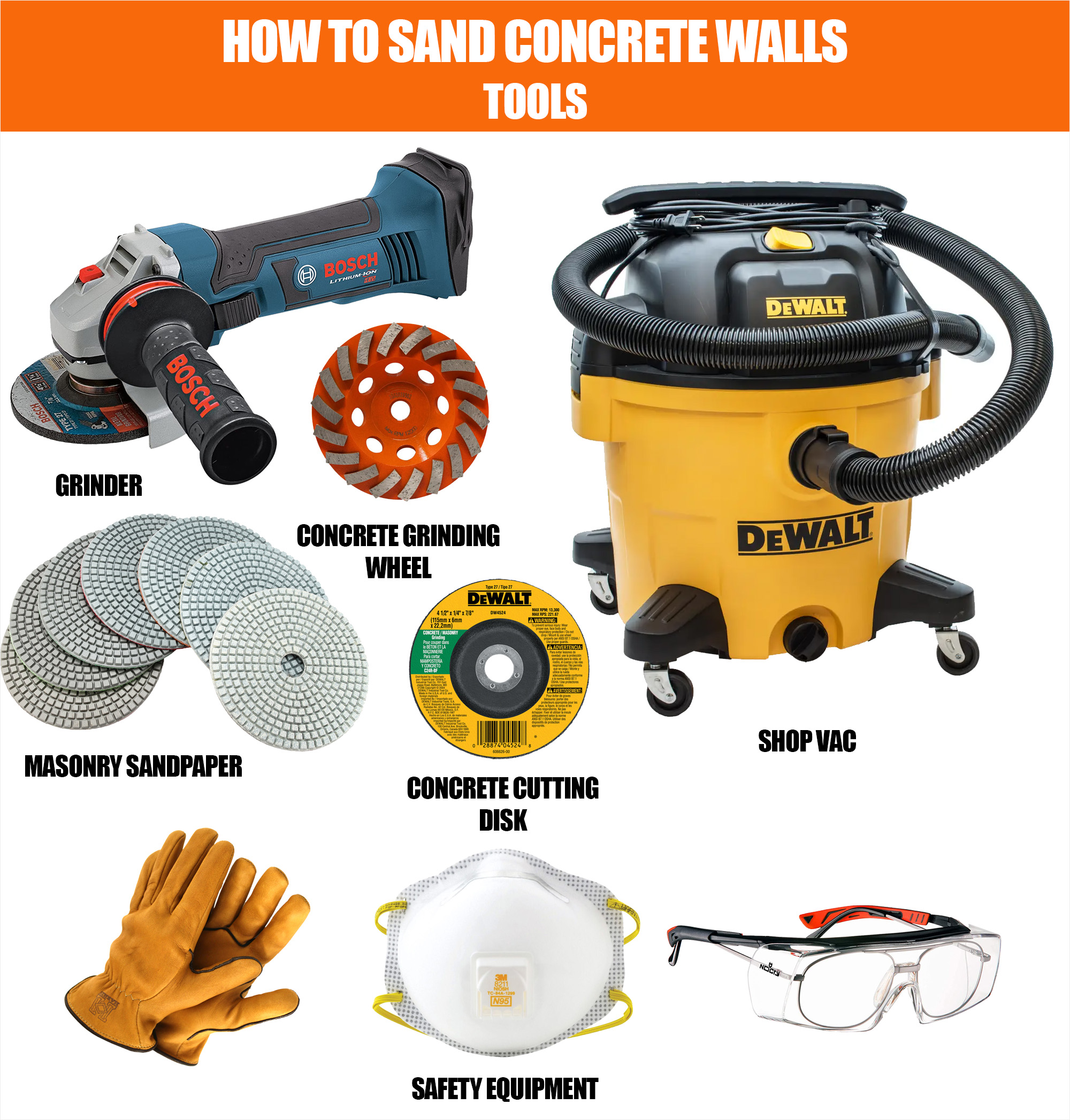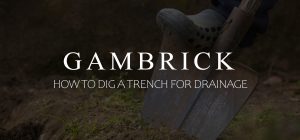
How To Sand Concrete Walls
Concrete is a very hard and dense material that’s typically poured into forms to build walls. When the forms are removed, the seams and imperfections of the forms show on the walls. This can either be a part of the walls appeal, such as with board formed concrete, or it can be an eyesore you’ll want to fix. If your concrete walls have some areas you’d like to smooth out then you’re in luck. You can sand concrete walls smooth with a concrete grinder, a concrete surface grinder, a fairly rough diamond grit sanding pad and either a belt or rotating sander.
Sanding a concrete wall smooth is a multi step process. First, you need to grind down any large chunks of concrete left by the forms. I use a small angle grinder and a diamond grit masonry blade. Use the blade to cut and grind down and chunks or pieces of concrete that protrude out from the surface. Make sure to wear a mask and goggles because grinding concrete makes a lot of dust and shoots out bits of concrete.
Once the surface of the concrete wall is free of protruding chunks and fairly flat, you can start to sand. Start with a concrete surface grinder to get the surface smooth. Then use a belt or rotating sander with a rough grit sandpaper. Wet the wall to cut down on dust and reduce heat. As you progress, you can use finer grit sandpaper for a smoother finish.
If you plan on hanging wallpaper on your concrete walls or painting, sanding the walls smooth can be an important first step. Click the link to see my list of the best paint for concrete walls.
Can You Sand Concrete Walls?
Concrete walls can be sanded if you know how and have the right tools. But it’s not easy to do. Concrete is a very hard, dense material so you need something even harder to sand it.
First, let’s talk a little bit about what concrete is.
Concrete is made by mixing sand, stone and cement with water. The amount of each material is called the concrete mix ratio. By varying the amount of each ingredient in the mix, you can change the characteristics of the concrete.
Most structural concrete walls are built with at least 3500 psi concrete. This is a very dense concrete mix that usually contains coarse masons sand and 3/4 inch stone aggregate. It’s not the easiest to sand down but it’s possible.
Non-structural concrete walls or walls that use concrete as a veneer usually contain less stone, more cement and finer sand. This makes them easier to sand smooth.
Before you start sanding your concrete walls, try to figure out how dense it is. If the wall is an outside wall, it’s probably structural which means it’s strong and hard. If the wall is somewhere inside the house, thin or a veneer, it may be softer concrete.
No matter what type of concrete that’s used to make your walls, you can still sand it. The job is just a little easier if the concrete is softer. And you can use finer and softer grit sandpaper.
Sanding concrete can be done either wet or dry. However, wet sanding cuts down on the dust. But be prepared, sanding concrete makes a lot of dust.

How Do You Sand A Concrete Wall?
I use a few different tools to sand a concrete wall. These include an angle grinder, a concrete surface grinder, a belt sander and a disk sander.
A concrete surface grinder will sand down and even out large areas of concrete. These are essential for sanding down a concrete wall that’s uneven.
Angle grinders can be used for sand small areas or to cut out sections of concrete that are protruding from the wall. This is very common at the seams where concrete forms meet. .
Once the grinding is done, I use a belt sander with a coarse grit sandpaper followed by a medium grit paper and an orbital sander.
make sure to use special masonry sandpaper and not regular sandpaper that’s designed for wood. masonry sandpaper contains diamond dust which is hard enough to sand concrete.
Wet Vs Dry Concrete Sanding
Both wet and dry concrete sanders will work on a concrete wall. Wet sanding has the advantage of less dust and heat, but the concrete dust clumps and makes a mess. Plus you have the water to deal with. If your concrete walls are in a finished area water may not be a good idea.
Dry sanding makes a lot of dust and more heat, but many concrete sanders come with a vacuum attachment that will suck up the dust as you sand. You can lay down tarps and plastic sheeting to contain the dust cloud. And a cool air fan can help reduce heat.
Wet sanding is a great option if you’re sanding off a significant amount of concrete. Because the grinder stays cool it can sand down concrete a lot faster and helps extend the life of the sanding pad. But wet sanding creates a dull finish.
A great way to sand a concrete wall is by using a combination if techniques. Try wet sanding the first pass to cut down large amounts of concrete followed by a dry sander for a fine finish.
If the concrete wall is on a finished area with nice floors, I always use a dry sander. It takes ore time, and costs more money, however, the dust can be controlled.
There are pros and cons to both methods of sanding a concrete wall, but ultimately they both work fine. Which you choose should be based on the job, how much concrete you need to sand, the finish you want to achieve and site conditions.
1. Preparation
The first step when sanding a concrete wall is always preparation. If you fail to properly prep the site and don’t get the right tools, you’ll have a very hard time sanding the wall and a lot of cleaning to do.
If you’re dry sanding, there will be a lot of dust. Make sure you move furniture and other belongings out of the room. Lay down tarps and tape plastic sheets around doorways. Try to contain as much of the dust in one area as you can.
Make sure you have a vacuum ready. Many dry sanders have a vacuum attachment built in. But not all. If your sander doesn’t have a built in vacuum, hold a vacuum hose close to the sander. It’ll suck up dust as you sand the concrete.
If you’re wet sanding, the water mixes with the concrete dust to create a slimy substance like paste. It’s messy and gets everywhere. make sure to cover the floors really well with tarps. The floors are going to get wet and cover with the concrete paste.
I always have a wet vacuum on hand when I wet sand concrete. Take breaks periodically to vacuum up water from the floor. Gather up the concrete paste with a flat head shovel or some paper towels. Try not to vacuum up the paste because it can clog the vacuum hose.
Wear protective gear like goggles, gloves and a mask when you sand concrete either wet or dry.
Pro Tip: Cover or close all the windows in the house. I’ve seen concrete dust blow out one window and back in through another which makes a total mess. Concrete sanding creates a very fine dust that can spread everywhere if you’re not careful.
2. Check & Repair The Walls
Before you begin sanding a concrete wall, you should always check for damaged areas. If you find cracks, they should be filled before you start sanding. Large cracks can be filled with new concrete or cement. Tiny cracks can be filled with very thin concrete sealant.
If you find a damaged or chipping area. Remove the damaged parts of the wall and make repairs with fresh concrete. When repairing old concrete with new concrete, make sure to coat the old concrete with a bonding agent first. The binding agent will make the new concrete stick to the old.
If there are large chunks of concrete sticking out from the wall, use the grinder to cut them flat with the wall’s surface. This is very common with poured concrete walls.
If you find mold or mildew, wash it off before you start sanding. Try a vinegar and water solution, a bleach and water solution, warm water and anti-microbial soap or a store bought cleanser. Never use a sander on mold because it will spread spores throughout the air.
Before you start sanding, you want a fairly even surface that’s free of cracks or damaged areas.
3. Start Sanding
When you sand a concrete wall, you always start with the coarsest grit first. Then you move down to the finer grits. Your first pass is usually with either a wet or dry sander using a concrete grinding wheel. They’re very hard and can sand down large amount of concrete quickly. However, they don;t leave a smooth finish.
I use the grinding wheel first to even out the surface of the wall and not really to smooth it. If there are uneven sections, the grinding wheel can fix it.
Once you’re done sanding with the grinding wheel, switch to a sander. Start with the toughest grit sandpaper you have. Sand the entire surface evenly. Once done, use a finer grit and sand the entire wall again.
I usually sand a concrete wall in 3 steps. A concrete grinding wheel to get the surface as level and even as possible. Then I use a coarse grit sandpaper followed by a medium grit sandpaper. Unless the wall has a really high cement content, there’s not much benefit to using a fine grit sandpaper. Most concrete can’t get too smooth because of the coarse material it’s made out of.
Between sanding sessions, I always clean up a bit. Use a vacuum to clean up dust and a wet vac to pick up water.
Sand the entire wall evenly with each level of sandpaper. be careful not to over sand an area because you could make the surface uneven.
To help me find uneven areas I place a long level or string a line against the wall. When you place something flat against a concrete wall it helps you find the uneven areas that need more sanding.
4. Hand Sanding
If there are areas you can’t sand with your grinder or sander, do it by hand. Place some sandpaper or a sanding pad on a 2×4 block or buy a small sanding block from Home Depot. Make sure you use a similar grit to the sandpaper you’re using on the sander. If you use a different grit the surface finish won’t match.
It’s much harder to sand concrete by hand than with a power sander, so I wouldn’t recommend it for large areas. But for small detail areas or hard to reach places, hand sanding may be the only option.
5. Sand In Different Directions
Each time you change the grit of the paper, go over the wall in a different direction. Sanding concrete with a hard grit can leave sand marks. When you sand again using a finer grit, go in the direction opposite to the harder grit. This will smooth out lines left by the previous sanding.
Continue to change sanding grit until you achieve the desired finish. Each time you use a finer grit, sand in the opposite direction of the previous grit.
How fine a sandpaper you ultimately use should be a judgement call you make on site. With some concrete surfaces, there’s no real benefit to sanding with a fine paper because the wall is too gritty. But some walls have finer sand or more cement which means you can sand them smoother.
When in doubt, try a small area with a finer sand paper. If the surface quality improves, sand the entire wall. The finer sand paper you can use the better the surface quality will be.
6. Cleanup
When you’re all done sanding, do a general cleanup of the room and wall. I like to wipe down the wall with a wet cloth. Use something tough enough to rub on concrete without fraying. Even though you’ve just sanded the concrete wall smooth, it’s still be rough compared to fine fabrics or a paper towel.
Try to get all the dust and residue off the wall. This will be harder if you wet sanded the wall because you’ll have to clean up all the concrete paste.
It’s important to get the wall really clean in this step because next you’ll be applying a liquid chemical hardener and possibly some polish or paint.
At this point, I don’t remove the tarps and plastic covering unless I’m not using a hardener, polish or paint. It all depends on how I’m ultimately finishing the concrete wall. However, if your just sanding the wall and not using any additional treatments or finishes, go ahead and do a thorough cleaning.
Make sure to remove the plastic covering the doorways last. When you clean the floor tarps, a lot of concrete dust will kick up into the air and spread throughout the house. Make sure you vacuum it all up and the air is clear before removing the doorway plastic.

Liquid Chemical Hardener
This is a completely optional step that you can skip if you want to. But for some concrete walls it’s important to help keep them strong. When you’re all done sanding and cleaning up, apply a thin layer of liquid chemical hardener to the wall.
Using a chemical hardener is more helpful for some walls than others. So it’s a judgement call you’ll have to make. If you’re concrete is brand new and very hard, I wouldn’t bother with the hardener. But if the wall is old and/or brittle in spots, I’d give it a try.
A hardener can help preserve a concrete wall’s durability.
Can You Sand A Concrete Wall With A Belt Sander?
Yes, I use my belt sander to sand down all sorts of concrete slabs including floors, countertops, tables, planters and furniture. We do a lot of custom concrete work and belt sanders are a great way to get the surface smooth. However, I wouldn’t use the belt sander to sand down chunks of concrete or really uneven areas. Use the grinding wheel to do most of the work first. Once the surface is fairly even, go ahead and use the belt sander to finish the job.
A belt sander is great for sanding the overall surface of a concrete wall smooth. But it’s not great at sanding down large uneven areas.
Can You Sand A Concrete Wall With An Orbital Sander?
Yes, I use an orbital sander along with my belt sander and a grinder to sand concrete walls. The 3 tools working together, along with a bit of hand sanding, provide the best finish.
First, use the grinder to sand down large uneven areas or protruding concrete. Then, go over the entire wall with the belt sander. Once the belt sanding is done, go over the entire wall again with the orbital sander. This time, switch to a finer grit sand paper.
Make sure to clean the wall in between sandings and sand in the opposite direction of the previous pass.
Does Regular Sandpaper Work On Concrete?
Regular sandpaper will work on concrete, but it’ll wear out really fast. Normal sandpaper is designed for wood so the grit isn’t tough enough to sand large areas of concrete.
Use diamond sandpaper that’s designed for concrete. Diamond sandpaper is made for masonry work and contains diamond dust which is tough enough to sand down concrete.
Masonry sandpaper comes in both wet and dry designs. make sure you use the right sandpaper based on the type of sanding you’ll be doing.
In addition to getting the right type of sandpaper, make sure you use the correct grit.
- Coarse grit is best as the first sanding after you’re done with the grinder. It sands more material but doesn’t leave the surface as smooth.
- Medium grit doesn’t sand as much material as coarse grit sandpaper but the finish is finer.
- Fine grit sandpaper leaves a smoother finish but doesn’t sand down as much concrete.
Always use the toughest grit sandpaper first followed by finer grits.
How Much Concrete Can Sanding Remove?
The first pass by a concrete grinder can remove as much as an 1/8th of an inch at a time. Concrete grinders are powerful tools so use them carefully. You don’t want to over-sand the wall or create uneven areas.
The sanding you do with a belt or orbital sander don’t remove as much concrete as the grinding wheel. A pass with a very hard grit sandpaper will remove less than 1/16th of an inch of concrete. The purpose of sandpaper is to smooth the surface and not to grind down large areas of concrete. That’s what the grinder is for.
When I sand down a concrete wall, I typically use 3 steps. One pass with the concrete grinding wheel, one with a hard grit sandpaper and a final sanding with a medium grit. In total, I generally remove about 3/16th to 1/4 of an inch of concrete from the overall surface of the wall.
Keep in mind this does not include the chunks of concrete I take out with the grinder. In some cases, I may take out inches of concrete. It’s not uncommon for concrete to protrude out from the wall at the form seams.
Finish Levels
There are a few different levels of finish when sanding a concrete wall. Think about the look and texture you want before you start sanding. Some people like a more gritty texture so they stop at a hard grit sandpaper.Others prefer a finer finish and go all the way down to a fine grit sandpaper. I usually stop at a medium grit.
If you plan on painting the wall, you don’t have to get it as smooth. Painting concrete walls also requires a primer coat which can help even out all the small imperfections.
Summary: How To Sand Concrete Walls
Concrete is a very hard and dense material that’s typically poured into forms to build walls. When the forms are removed, the seams and imperfections of the forms show on the walls. This can either be a part of the walls appeal, such as with board formed concrete, or it can be an eyesore you’ll want to fix. If your concrete walls have some areas you’d like to smooth out then you’re in luck. You can sand concrete walls smooth with a concrete grinder, a concrete surface grinder, a fairly rough diamond grit sanding pad and either a belt or rotating sander.
Sanding a concrete wall smooth is a multi step process. First, you need to grind down any large chunks of concrete left by the forms. I use a small angle grinder and a diamond grit masonry blade. Use the blade to cut and grind down and chunks or pieces of concrete that protrude out from the surface. Make sure to wear a mask and goggles because grinding concrete makes a lot of dust and shoots out bits of concrete.
Once the surface of the concrete wall is free of protruding chunks and fairly flat, you can start to sand. Start with a concrete surface grinder to get the surface smooth. Then use a belt or rotating sander with a rough grit sandpaper. Wet the wall to cut down on dust and reduce heat. As you progress, you can use finer grit sandpaper for a smoother finish.
With enough time and effort, you can sand a concrete wall very soft and smooth.
If you have any questions or comments about concrete, email any time.

John Mazzuca | About | More Posts |
Custom Home Builder
John Mazzuca is a custom home designer and builder at Gambrick with over 25 years experience in the construction industry. John has designed, built and/or remodeled hundreds of homes, small buildings, and commercial projects. He writes about business, real estate, home building, and household electronics. His work has been featured in Fox Business, Better Homes & Garden, House Beautiful, and more.



















